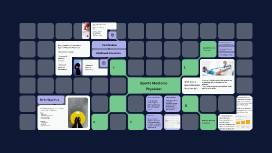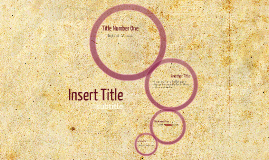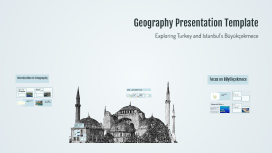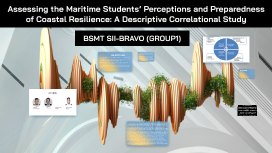Geography Presentation Template
Transcript: Geography Presentation Template Exploring Turkey and Istanbul’s Büyükçekmece Introduction to Geography Focus on Büyükçekmece Turkey - A Geographic Overview Importance of Geography Physical vs. Human Geography Key Attractions Geography helps us comprehend spatial relationships and the impact of location on cultural, economic, and political dynamics. It's essential for urban planning, environmental conservation, and global awareness. Physical geography focuses on natural features and processes, such as landforms and climate, while human geography examines societal dynamics, urban development, and cultural landscapes. Location within Istanbul Major Regions of Turkey Climate and Environment Location and Borders Cultural Geography Turkey features a varied climate, ranging from Mediterranean along the coast to continental in the interior. Its rich natural resources and biodiversity, including mountainous terrains and fertile plains, support agriculture and wildlife, making Turkey ecologically significant. Turkey is divided into seven diverse geographical regions: Marmara, Aegean, Mediterranean, Central Anatolia, Eastern Anatolia, Southeastern Anatolia, and Black Sea. Each region boasts unique climatic conditions, cultures, and historical sites, reflecting the country’s rich tapestry of diversity. Nestled at the crossroads of Europe and Asia, Turkey is bordered by eight countries, including Greece and Armenia, with coastlines along the Aegean, Mediterranean, and Black Seas. This strategic location has historically made Turkey an important hub for trade and cultural exchange. The cultural geography of Turkey is characterized by a blend of traditions influenced by various civilizations, from Byzantine to Ottoman. This cultural mix is evident in Turkey's architecture, arts, and cuisine, symbolizing the harmonious coexistence of diverse ethnic groups and religions. Büyükçekmece is located on the European side of Istanbul, along the coast of the Sea of Marmara. It serves as a vital transit point connecting the city’s urban life with its natural landscapes. Büyükçekmece is home to several attractions including the Büyükçekmece Beach, known for its recreational activities, and the historic Büyükçekmece Aqueduct, an architectural marvel of the Ottoman period. Geographic Information Systems (GIS) Overview of Major Geographic Features Environmental Features GIS technology allows for the visualization and analysis of spatial data. It plays a critical role in various fields, including urban planning, environmental management, and disaster response. Major geographic features include mountains, rivers, deserts, and plains. Understanding these features is vital for grasping climate patterns, biodiversity, and human settlement adaptability. Cultural Significance and Development The district boasts scenic beaches along the coast and expansive parks, contributing to its biodiversity. Its proximity to the Sea of Marmara offers unique coastal ecosystems, making it a favorable spot for both locals and tourists. Büyükçekmece has evolved into a vibrant cultural hub, showcasing various festivals and events that highlight its heritage. The district reflects a blend of modern developments and traditional lifestyles, making it a unique part of Istanbul. Istanbul - The City of Many Layers Historical Significance Istanbul, formerly known as Byzantium and Constantinople, is steeped in over 2,500 years of history. It has served as the capital of three empires: Roman, Byzantine, and Ottoman, making it a focal point for cultural and political transformations in the region. Geographic Features Economic Importance Istanbul is Turkey's economic powerhouse, contributing significantly to the nation's GDP. It hosts major industries such as trade, manufacturing, tourism, and finance, making it a critical hub for commerce. Istanbul spans two continents, Europe and Asia, divided by the Bosporus Strait. Its unique topography includes the Golden Horn, a natural harbor, and hills that provide stunning views of the city’s skyline and waterways. Demographics and Population Distribution Istanbul is home to over 15 million residents, making it one of the largest cities in the world. Its population is diverse, with various ethnic backgrounds and cultures, contributing to its vibrant social fabric.

















